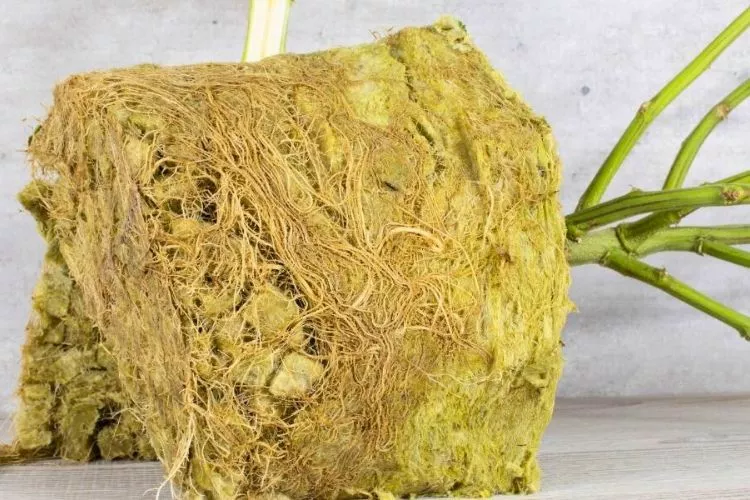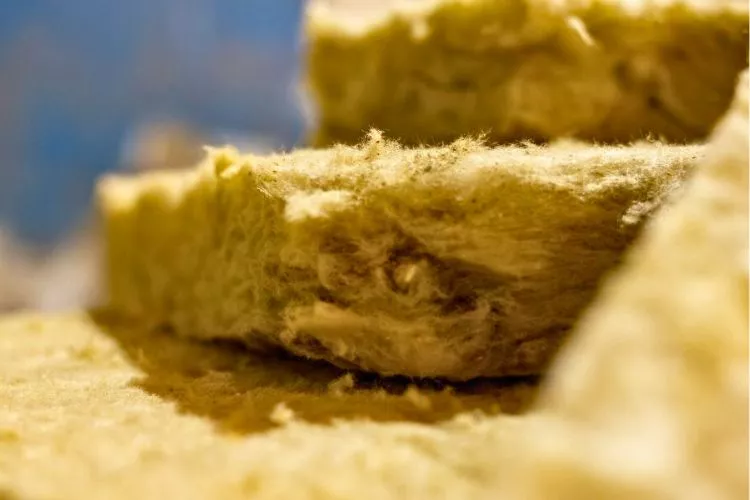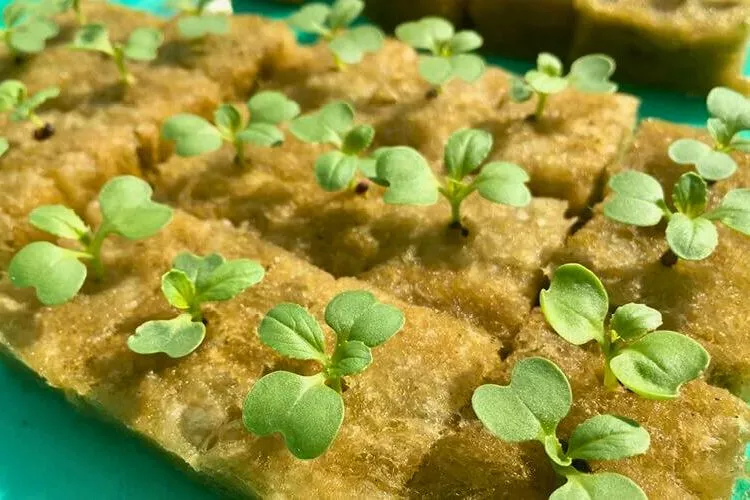Hydroponic growers frequently use Rockwool because of the material’s high capacity to hold moisture while allowing for adequate air circulation.
But what happens to the rockwool when a harvest is done? Can you reuse rockwool for hydroponics?
Yes; you can actually reuse rockwool for hydroponics. However, incorrect reuse can cause plant disease and stunted development. That’s why we need to be careful while doing it.
In this piece, we’ll discuss the pros and cons of using Rockwool in hydroponics and demonstrate how to properly clean, sanitize, and utilize the material. We advise you to protect your plants’ health and cut costs.

Table of Contents
What is rock wool?
Rockwool, known as mineral wool, is a popular growing medium for hydroponics made from spun rock fibers. It’s widely used in commercial and hobbyist hydroponics due to its excellent water retention and aeration properties.
Manufacturing Process and Types Of Rockwool
Natural igneous rock or repurposed materials like slag or glass are melted down and woven into strands to create Rockwool.
Hydroponic systems can use the fibers after they have been compacted into blocks, slabs, or loose fibers. Depending on their density, height, and form, rockwool can be one of the following:

- Rockwool cubes: Small, square, or rectangular cubes ideal for seed germination or small plants.
- Rockwool slabs: Larger, rectangular slabs are perfect for larger plants and can be cut to size.
- Rockwool fibers: Loose fibers can be used to create custom-sized growing beds.
Advantages and Disadvantages of Using Rockwool in Hydroponics
Advantages
✅ Superior ability to hold and release water for optimum root development and plant health.
✅ Better agricultural production and quality thanks to reliable water and nutrient supply
✅ The potential for long-term expense reductions due to the reuse
✅ Low effort in terms of both initial and ongoing preparation and upkeep
Disadvantages
❌ Potential for nutrient imbalances due to rockwool’s alkaline nature, which can require more precise pH monitoring and adjustments
❌ Risk of excess salt accumulation, which can lead to nutrient toxicity and plant stress
❌ Improper disposal of used rockwool can be an environmental concern.
❌ Limited availability in some areas, which can make it more difficult to obtain
Can you reuse rockwool for hydroponics?
In a word, yes, Rockwool can be used again in hydroponics. Recycling rockwool is easy and inexpensive to keep your hydroponic setup running smoothly. However, before recycling rockwool, it must be thoroughly cleaned and disinfected to eliminate any risk of infection from bugs, diseases, or nutritional imbalances.
Factors to consider before reusing Rockwool include the pH and nutrient levels, age of the Rockwool, storage conditions, and water quality.
By considering these factors and properly preparing the Rockwool, you can successfully reuse it in your hydroponic system.
Cleaning and disinfecting Rockwool for reprocessing in hydroponics involves submerging the Rockwool in a bleach or hydrogen peroxide solution and then washing it completely with clean water.
Make sure the Rockwool is correctly rehydrated to absorb and store water and minerals for your plants.
How to Reuse Rockwool for Hydroponics?
Using Rockwool repeatedly in hydroponics is a fantastic method to save money and resources.
However, if you want to keep your plants healthy and prevent stunted development, sanitize and sterilize them regularly. Let’s have a look at how to recycle rockwool for hydroponics:

Factors to Consider Before Reusing Rockwool
Before reusing rockwool, it’s crucial to consider the following factors:
- Previous crop: The nutrient content and pH of rockwool can vary depending on the plants produced there. When reusing rockwool, it’s ideal to do so with plants of the same species or comparable nutrient needs.
- Disease and pest infestations: If the Rockwool was previously infected with a disease or pest, it’s best to dispose of it to avoid contamination in the new crop.
- Overall health: The condition of the Rockwool can also affect the success of reusing it. If it appears damaged, degraded or has a foul odor, it’s best to dispose of it.
- Age of the Rockwool: For optimal results, only use a rockwool that is less than two years old, as its ability to retain water and minerals decreases with age.
- Storage conditions: It’s possible that mildew and other pathogens grew on the Rockwool because it was incorrectly kept, like in a moist or humid area.
- Water quality: Rockwool’s pH and nutrient content can be altered depending on the water used to moisten and saturate it. Use only pure, pH-balanced water.
How Do You Rehydrate Rockwool?
It is essential to moisten rockwool before using it in a hydroponic system to absorb and store water and fertilizers effectively. Here’s how to get rockwool back to life:
- Soak the Rockwool in pH-balanced water for at least an hour. The water should have a pH of 5.5-6.5.
- Remove any extra moisture from the Rockwool by squeezing it.
- Place the Rockwool in a clean, pH-balanced nutrient solution and let it soak for at least an hour.
- Before incorporating rockwool into your hydroponic system, squeeze out any extra fertilizer solution.
Steps to Properly Clean and Disinfect Used Rockwool
To properly clean and disinfect used rockwool, follow these steps:
- Remove all plant debris and roots from the rockwool.
- Soak the Rockwool in a pH-balanced solution for at least 24 hours. Use a pH test kit to ensure the solution has a pH of 5.5-6.5.
- Rinse the Rockwool thoroughly with clean water to remove any remaining debris or solution.
- Disinfect the rockwool with a hydrogen peroxide solution and water or another suitable disinfectant. Follow the manufacturer’s instructions for the correct dilution and application.
- Rinse the rockwool thoroughly again before use.
Tips for Successful Rockwool Reuse in Hydroponics
To ensure the successful reuse of rockwool in hydroponics, consider the following tips:
- Monitor pH and nutrient levels: Reused rockwool can retain nutrients and salts from the previous crop, so monitoring pH and nutrient levels closely is crucial.
- Pre-soak the rockwool: Before planting new crops, it’s best to pre-soak the rockwool in a nutrient solution for a few hours to ensure it’s properly hydrated.
- Rotate crops: To avoid nutrient depletion and disease buildup, it’s best to rotate crops when reusing rockwool.
Precautions to Take While Reusing Rockwool
To avoid disease and poor plant growth, take the following precautions while reusing rockwool:
- Wear gloves and protective clothing when handling used rockwool to avoid skin irritation.
- Disinfect the rockwool thoroughly before reuse to avoid disease contamination.
- Dispose of any rockwool that appears damaged, degraded, or has a foul odor.
- Avoid reusing rockwool too often, as it can lead to nutrient depletion and poor plant growth.
What Can I Do with Leftover Rockwool?
If you have leftover rockwool from your hydroponic system, you may wonder what to do with it. Here are some examples:
- Use it as a seed starter: Rockwool can be an excellent medium for starting seeds before transplanting them into your hydroponic system.
- Add it to potting soil: Rockwool can also be added to potting soil to improve drainage and aeration.
- Insulate your home: Rockwool can also be used as insulation, as it has excellent heat and sound insulation properties.
When to Replace Rockwool?
Hydroponic systems benefit from Rockwool’s durability and longevity as a growth substrate.
However, it may become tainted or worn out over time and require replacement. If you’re wondering whether or not your rockwool needs to be replaced, here are some indications that it probably does:

- Compaction or hardening of the rockwool reduces its receptivity to water and minerals.
- Discoloration or a foul stench in rockwool could indicate the existence of bugs or diseases.
- The rockwool’s pH and nitrogen levels have become unbalanced, stunting plant development.
To avoid problems with bugs and illnesses, it’s important to periodically replace your rockwool. The greatest practices for rockwool repair include, but are not limited to, the following to guarantee the greatest results:
- Discard any contaminated or worn-out Rockwool.
- Clean and disinfect the hydroponic system thoroughly before introducing the new rockwool.
- Properly hydrate and prepare the new rockwool before planting.
Frequently Asked Questions (FAQs)
Can rockwool be reused indefinitely?
No, Rockwool cannot be reused indefinitely. Over time, it may become contaminated or worn out and must be replaced.
What is the best method to disinfect rockwool?
The best method to disinfect rockwool is to soak it in a hydrogen peroxide or bleach solution and then rinse it with clean water.
Can rockwool be recycled?
Yes, rockwool can be recycled. Contact your local recycling center to see if they accept Rockwool.
Can reused rockwool affect plant growth?
Reused rockwool can affect plant growth if not properly cleaned and disinfected. Following proper preparation and care is important to ensure optimal plant health.
Conclusion:
In conclusion, rockwool can be a cost-effective and eco-friendly solution for maintaining a hydroponic system.
You can ensure optimal plant health by considering the factors before reusing, properly cleaning and disinfecting, and knowing when to replace Rockwool. We hope that this guide has been helpful.
Check back again soon for more information and similar topics on our website.


